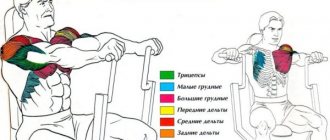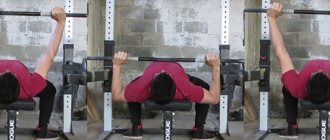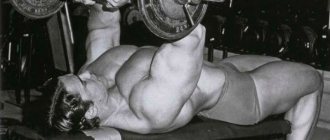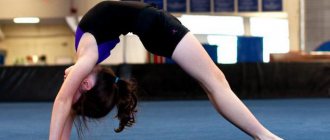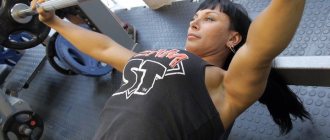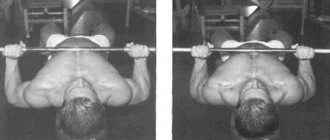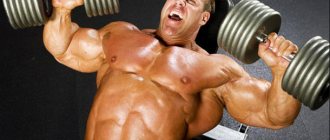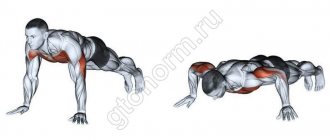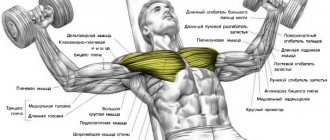What is a bridge?
The bench press is a basic, multi-joint movement that involves several muscle groups. The main load falls on the chest muscles, triceps and anterior deltoids provide auxiliary function.
A bridge is a strong arch of the back during a bench press, in which the buttocks barely touch the bench, and the shoulder blades and legs become the supporting points. With this technique, the latissimus dorsi muscles and even the legs are also included in the work. Therefore, the benefit or harm of the bridge is determined by the goal that the athlete faces - strength or mass?
Bench press bridge
Many bodybuilding athletes wonder if they need to bridge their bench press. It is believed that this technique is suitable primarily for powerlifters, and for those who work to gain muscle mass, it will not give anything.
In fact, the bench press bridge will provide you with certain benefits. We’ll talk about what they are and how you need to perform the exercise to count on them below.
Why is a bridge needed?
The bench press bridge technique is not very difficult, the main thing is to adapt. By also regularly performing the exercises in question, you can count on the following benefits:
- If you decide to do a bridge bench press, remember that in addition to the pectoral muscles and shoulder girdle muscles, the “wings” work in this case. The load on them is created immediately at the moment the bar is lowered.
- The gap between the human body and the barbell decreases, which means the amplitude decreases. That is, you can work with heavy weights without risking your health.
- When performing a regular bench press, it is most difficult for an athlete to overcome the lowest point of the amplitude. If you are making a bridge, this problem will not be so pressing.
As you can see, the technique in question has certain advantages. However, in order to use them, you must perform the exercise correctly. So be careful about the position of your body and arms.
Bridge technique in bench press
The correct technique for performing the exercise in question implies that the athlete leans on his feet and shoulder blades. Your legs should be your support, so don't let them just hang in the air. But there is no need to use the gluteal muscles when performing the bridge.
Don't strain them, but don't use them as a support either. It will be ideal if you leave your buttocks lying quietly on the bench, transferring your weight to your upper back and feet. And if you feel the strength to rise higher, your buttocks can only touch the surface of the bench.
To maximally work the pectoral muscles, unloading the deltoids and triceps, squeeze your shoulder blades together at the very beginning of the exercise. You need to stay in this position for as long as possible - tighten your upper back, and don't let your shoulder blades relax until you finish lifting the barbell.
By following all of the listed rules for the bridge technique in the bench press, you can not only maximize the effectiveness of the exercise, but also avoid injury. And this is very important when it comes to strength exercises with large weights.
How to prepare your body for stress
Since the exercise in question is related to powerlifting, it is quite difficult to perform. And if an athlete does not feel able to bridge the bench press, perhaps he should practice.
First of all, learn how to do an ordinary gymnastic bridge, as well as a bridge with weights. And only when your back muscles are ready for serious loads can you combine this exercise with a bench press.
The depth of the bridge may not be the same - it depends on the specific training of each athlete. However, in any case, it is important that the body is securely fixed and that you do not experience discomfort. After a few trials and errors, you will definitely be able to understand for yourself whether you need to do the bench press with or without a bridge.
Otherwise, the risk of injury increases. So if you want to experiment with a new exercise, be as careful as possible. Learn the bench press bridge technique and follow simple rules, then you can improve your physical performance.
Video about the bridge technique in the press
Source: massafm.ru
Bridge in bodybuilding
For bodybuilders, the main role is played not by strength, but by muscle volume, so they do not use a bridge in their training.
- If you want to have a massive chest, then when bench pressing as much of the load as possible should fall on it, and not be distributed throughout the body. And to avoid stress on the back and legs, the buttocks must be pressed tightly against the bench. The deflection should only be in the lumbar spine,” comments Sergei Yugay, bronze medalist of the open bodybuilding championship of North-West Russia .
Bench Press Bridge Benefits
The bench press bridge is a detail of the exercise that provides certain benefits.
Most of those who regularly visit the gym, but are not powerlifters, believe that such a technique will not give them anything and simply neglect it. But in vain. In this article we will talk about the benefits of the bench press bridge and its technique. Well, at the end of the article you can watch the bridge in the bench press on a video that will clearly show what it is.
Bench press bridge: its advantages and relevance
Advantage number 1
The main thing is the ability to include the latissimus dorsi muscles in the bench press, at the moment when the barbell is lowered to the chest.
Advantage number 2
The second benefit of the bridge in the bench press is less relevant for increasing the pectoral muscle, but is very relevant for increasing the weight on the bar. With this execution, the distance from the top point where you need to lift the barbell to your chest is slightly reduced. It follows from this that you will have to lift the barbell to a lower height from the chest, which will definitely be a plus.
Advantage number 3
When lowering the barbell to your chest while lying on the bridge, you automatically get the opportunity to have some shock absorption of the barbell from your chest, which can greatly help at the lowest, and therefore heaviest, point of amplitude, precisely at the initial moment when the barbell is removed from the chest. Everyone has ever bench pressed a barbell from the chest, they know that the most difficult thing to pass is the lowest point of the amplitude, which is also called the “dead point”. You can even hear the following expression: “Breaking through the dead center” or “The main thing is to get through the dead center.” This is exactly where the bridge in the bench press can help, which is the third significant advantage of the bridge in the bench press.
Subtleties of the technique of performing a bridge in the bench press
It goes without saying that when performing a bridge press, you should always remember the correct technique for performing the exercise. A lot of it has to do with the position of your feet. Under no circumstances should they just hang around the bench. In this exercise, as in many others, by the way, they should serve as a solid support and basis for you to perform the movement. Basically, you have to stand or lean, whatever you want to call it, on your feet and shoulder blades. As for the buttocks, in this exercise they should not serve as a support, but they should not hang over the bench. Your butt should just rest on the bench or even touch it as you bridge the bench press.
The correct technique for the bench press on the bridge, as in many other exercises, is needed not only to achieve the goal, but also, first of all, to avoid various types of injuries.
Exercises that help develop a bridge in the bench press
Assistance exercises that can help develop the bridge and subsequently assume the correct bridge position for the bench press typically use classic wrestling or gymnastics bridges to develop the flexibility of your back. Which will then be very necessary for the bridge bench press. At first, you can use a thick roller for these purposes, which can even be made from a towel. It should be placed under the lower back, a little closer to the chest, when you are training to stand on the bridge. If you are interested in the correct squat technique or deadlift technique, I recommend reading these articles.
Another useful tip : when performing the bench press, try to squeeze your shoulder blades as tightly as possible every time you do a bridge and do not let go throughout the entire exercise. This will help you hold the bridge better and feel the pectoral muscles better and shift the load from the triceps and deltoids to the chest.
Epilogue
The bridge bench press is an exercise technique that is mainly suitable for professional powerlifters; we can say that it is the prerogative of powerlifting professionals. This technique is not simple and it is aimed at maximum results. Just like the stiff-legged deadlift, this is a very specific exercise. And if you are able to master it and practice it in training, then you will definitely get quite a lot of benefits. And even if you cannot do such a bridge when pressing, which is shown in the video below, then do not despair. And even if you just don’t have the desire to do such a bridge as in the video, then in any case the general rules for performing the bench press are the same for everyone. But the depth of the bridge is a purely individual matter, but it should be present in every athlete performing a bench press.
Bench press bridge on video and some
Now let’s watch the bridge in the bench press on video. The first video does not demonstrate the correct technique, but some kind of diarrhea. You can't do that. The body must be firmly fixed. Ideally, one breast should work, and not as this clown’s body position changes all the time.
Video number 1 - doing this is strictly prohibited!
The second video demonstrates the correct technique for bench pressing a barbell in a bridge position. The girl performs the exercise, and she does it very confidently and technically. As for me, everything was done correctly from a technical point of view.
Video number two - this is how you need to do the bench press bridge!
Well, the third video, which shows one of the techniques with which you can develop flexibility in the back.
Video number 3 is an example of developing back flexibility to perform a bridge in the bench press.
Train and you will be happy.
Sports Factor.
Source: faktor-sporta.ru
This is interesting: Crunches on a block: an exercise for the abs, technique and practical recommendations for performing crunches in a crossover
Bridge in powerlifting
Representatives of strength sports (powerlifters and benchers), on the contrary, say that the bridge is a mandatory component of the bench press, and it even needs to be specially trained and developed. The only goal of a powerlifter is to lift maximum weight, and to achieve this goal, all means are good.
Naturally, by engaging such strong and bulky muscle groups as the legs and back, you can bench press a much heavier barbell. In addition, a protruded chest reduces the amplitude of movement, and this greatly facilitates lifting the barbell, because it is in the lower part of the amplitude that the dead point is usually located. Another advantage of the bridge is that the protruding chest absorbs the barbell and pushes it upward, like a spring.
Bench press bridge[edit | edit code]
Yuzhakov Anton Most in the bench press
Bench press bridge.
If it looks stupid but it works...it's not stupid.
Bridge
- This is a back arched position in the bench press exercise, which allows powerlifters to achieve several advantages:
- Firstly, the range of amplitude between the extreme points is reduced, and lifting the barbell a shorter distance makes lifting the weight much easier. Especially considering that the “dead point” is at the bottom of the amplitude.
- Secondly, the bridge allows you to use auxiliary muscles, primarily the latissimus dorsi.
- Thirdly, when lowering the barbell onto the chest, it becomes possible to absorb shock at the bottom point of the takeoff and at the very beginning of removing the barbell.
Technique[edit | edit code]
When performing a bridge press, special attention should be paid to the technique of its implementation. A powerlifter actually has two support points in this element: the shoulder blades and the feet.
In this exercise the legs
should serve as a strong support and basis for performing the movement. Feet should be wide apart for stability. The feet must be fully on the platform. In addition, they should be brought back, as close to the shoulders as possible. Tearing and moving them during the press is strictly prohibited by the rules. Therefore, immediately try to place them as convenient for you, within the rules. Shoes should be such that they do not slip, because the stability of your feet greatly affects the result; a significant part of the load is transferred to them (if you do everything correctly, of course).
shoulder blades
should be brought together as much as possible.
Basically, you have to stand or lean on your feet and shoulder blades. But the buttocks
should in no way become like that, since when performed correctly they simply touch the bench.
You should choose this elbow position
, in which the load will be evenly distributed between all muscle groups: pectoral, anterior deltoids and triceps. If the elbows are pressed to the body in the bench press, then the deltoids and triceps are maximally loaded; if the elbows are maximally apart, then the pectoral muscles are loaded. To lift maximum weight, the optimal position is in which the angle between the body and the humerus is about 45°.
Brushes
try not to bend, and to stiffen them and also to avoid injury, always wrap your wrists with elastic bandages.
The grip of the barbell
should be the maximum width allowed. those. 81 cm.
To take the starting position, you must first place your legs on the bench, and having arched the “bridge,” lower your legs from the bench to the floor and take a stable position, resting your feet. The main goal: to “pull” the shoulders as close to the pelvis as possible.
The movement of the bar both down and up should be uniform and slow. When the bar just barely touches your chest, you need to stop it without pressing it into your chest. And no repulses. This will already be a bench press, which is not a competitive exercise. Try to hold the barbell with the strength of your hands, as otherwise the barbell will not be torn off your chest if your hands are overloaded. Then sharply squeeze the barbell along the same trajectory as it was lowered onto the chest. This trajectory, as you should notice, is not entirely straight, but resembles an arc. When the barbell is torn from the chest, the movement should come from the legs by tensing them towards the head. And since this movement occurs parallel to the bench, this is how you maintain your contact with it. Try not to lift your pelvis off the bench.
Compliance with all the subtleties of the exercise technique allows you not only to achieve the desired effect, but also protects you from accidental injury.
Exercises for training the bridge[edit | edit code]
- it is recommended to include regular gymnastic or wrestling bridges in the warm-up program
- in the first stages of including this complex exercise in the training program, it is permissible to place a thick cushion under the lower back, closer to the thoracic region
- to develop arching in the bridge press, use the classic cobra yoga exercise
- Exercise "cobra"
- Gymnastic bridge
Proper Bridge Technique
Since the legs act as one of two support points, they should be widely spaced and never leave the floor during the entire approach. The second support point is the shoulder blades. They should be brought together and literally pressed into the bench.
The shoulders need to be pulled as close to the pelvis as possible - the stronger the deflection, the more weight the athlete can take. The grip should be as wide as possible - this will also reduce the range of movement. Current rules allow a grip no wider than 81 cm.
Bridge Development Exercises
To develop the flexibility needed for a bridge, it is helpful to stretch before and after each workout. The warm-up before the bench press must include gymnastic and wrestling bridges, as well as the “cobra” exercise from yoga - simultaneous lifting of the arms and legs while lying on the stomach.
Photo: from personal archive
Zakir Naimanbaev, vice-world champion and Asian champion in powerlifting, comments:
To improve your bridge, when performing a bench press, you can place a bottle of water or a bolster under your back and bend under it as much as possible. The size of the lining should be gradually increased. For example, at first you will use a half-liter bottle, a week later you will use a liter bottle, and so on. You can also place a barbell with weights or fix it in a Smith machine and bend under it while standing. Do 4 sets of 6 times. This will give a good stretch in the lower back area. I note that the bridge makes the amplitude of movement much smaller, and due to this, the result in the bench press becomes 10-15% greater.
#Bodybuilding #benchpress #bridge #Powerlifting
Previous Scientists have proven that the best way to prepare food is frying
Next The immune system remembers all viruses
Leave a comment (Cancel)
Exercises to develop a bridge in the bench press
The first obstacle to mastering the bridge press is spinal flexibility.
The less flexibility, the more time you will have to spend practicing the position.
There are lucky people who naturally have good flexibility. Such people master all the nuances within a few training sessions.
Most people need to do additional exercises to speed up the process of mastering the technique.
Here they develop general flexibility of the spine and perform special movements that improve flexibility during a specific exercise.
One of the best exercises for overall flexibility is the gymnastic bridge.
You don't have to master its full range of motion. It is enough to bend backwards while standing with your back to the wall bars.
To maintain balance, you can hold onto the wall with your hands, gradually increasing the amplitude of the tilt.
Practice this position 3-5 times a week, holding the bottom position for 15-20 seconds.
Consider an exercise to develop special flexibility of the spine:
- When performing a bench press, place a small dumbbell on a bench under your lower back. For example, 2-3 kg
- A person needs to make such a bridge so as not to touch the dumbbell with his lower back
- The chest press is performed in this position.
When you manage to do the exercise technically correctly, you can place a dumbbell of a larger diameter on the bench.
Continue to progress until you achieve the necessary flexibility in your spine.
